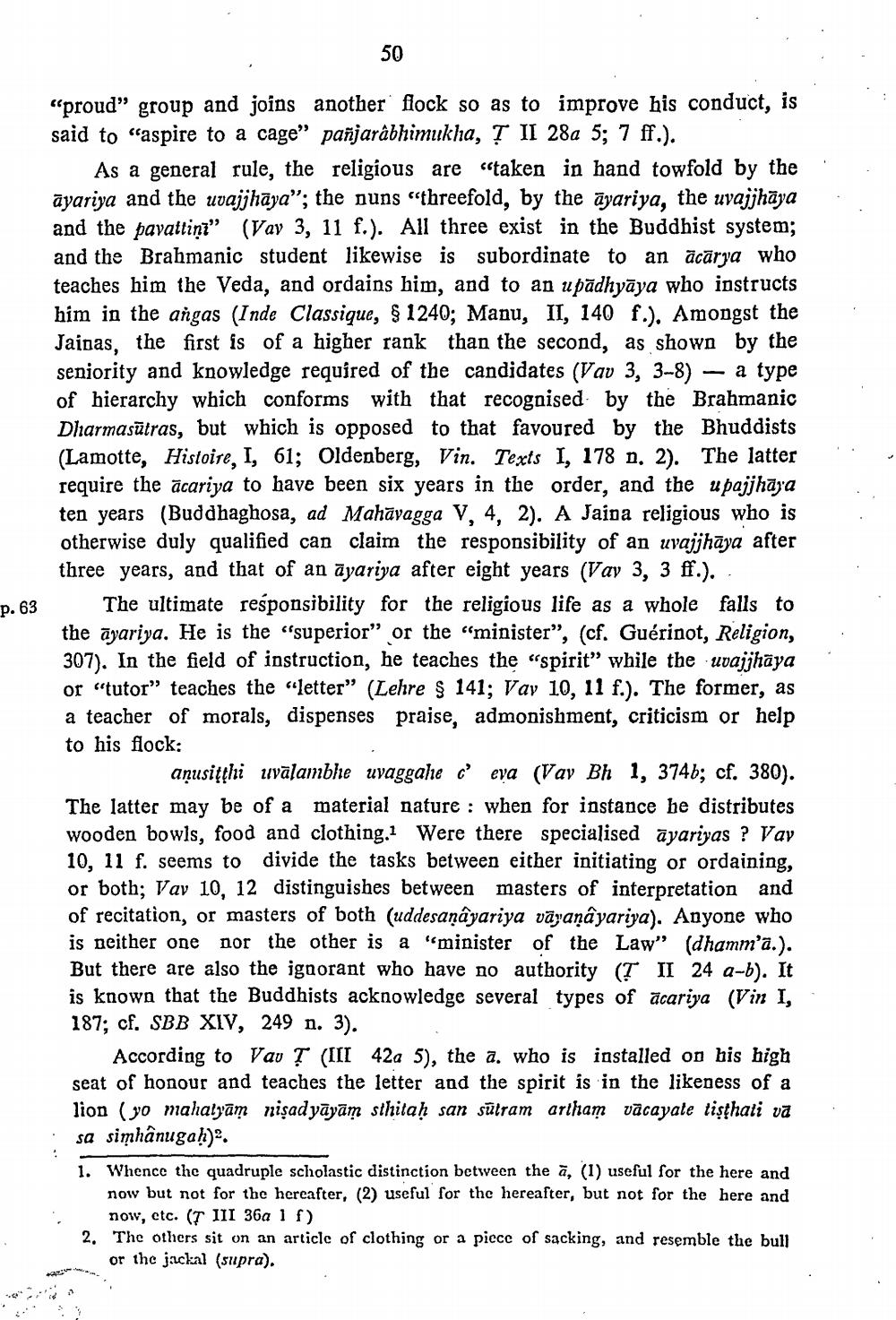________________
.
p. 63
50 “proud” group and joins another flock so as to improve his conduct, is said to "aspire to a cage” pañjarâbhimukha, Ţ II 28a 5; 7 ff.).
As a general rule, the religious are taken in hand towfold by the . āyariya and the uvajjhāya”; the nuns threefold, by the āyariya, the uvajjhāya and the pavattiņi" (Vay 3, 11 f.). All three exist in the Buddhist system; and the Brahmanic student likewise is subordinate to an ācārya who teaches him the Veda, and ordains him, and to an upādhyāya who instructs him in the angas (Inde Classique, $1240; Manu, II, 140 f.). Amongst the Jainas, the first is of a higher rank than the second, as shown by the seniority and knowledge required of the candidates (Vav 3, 3-8) - a type of hierarchy which conforms with that recognised by the Brahmanic Dharmasūtras, but which is opposed to that favoured by the Bhuddists (Lamotte, Histoire, I, 61; Oldenberg, Vin. Texts I, 178 n. 2). The latter require the acariya to have been six years in the order, and the upajjhāya ten years (Buddhaghosa, ad Mahāvagga V, 4, 2). A Jaina religious who is otherwise duly qualified can claim the responsibility of an uvajjhāya after three years, and that of an āyariya after eight years (Vay 3, 3 ff.). -
The ultimate responsibility for the religious life as a whole falls to the āyariya. He is the superior" or the minister", (cf. Guérinot, Religion, 307). In the field of instruction, he teaches the “spirit" while the uvajjhāya or "tutor" teaches the “letter" (Lehre § 141; Vay 10, 11 f.). The former, as a teacher of morals, dispenses praise, admonishment, criticism or help to his flock:
aņusițțhi uvālambhe uvaggalie c eva (Vav Bh 1, 374b; cf. 380). The latter may be of a material nature : when for instance he distributes wooden bowls, food and clothing. Were there specialised āyariyas ? Vay 10, 11 f. seems to divide the tasks between either initiating or ordaining, or both; Vay 10, 12 distinguishes between masters of interpretation and of recitation, or masters of both (uddesanâyariya vayanâyariya). Anyone who is neither one nor the other is a "minister of the Law" (dhamm'a.). But there are also the ignorant who have no authority (T II 24 a-b). It is known that the Buddhists acknowledge several types of acariya (Vin I, 187; cf. SBB XIV, 249 n. 3).
According to Vav T (III 42a 5), the a. who is installed on his high seat of honour and teaches the letter and the spirit is in the likeness of a lion (yo mahalyam nişad yāyām sthitah san sūtram artham vācayate tisthati va sa simhânugah). 1. Whence the quadruple scholastic distinction between the a, (1) useful for the here and
now but not for the hereafter, (2) useful for the hereafter, but not for the here and
now, etc. (T III 36a 1 f) 2. The others sit on an article of clothing or a picce of sacking, and resemble the bull
or thc jackal (supra).




